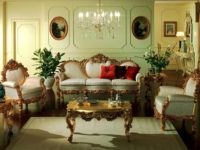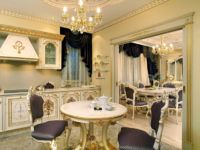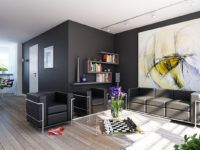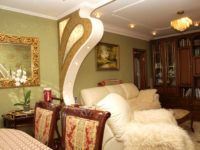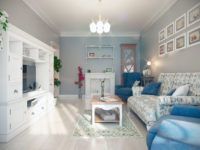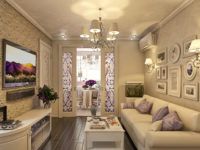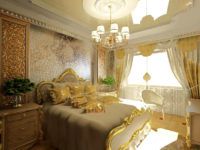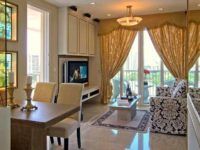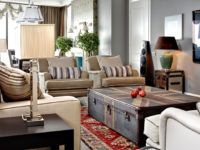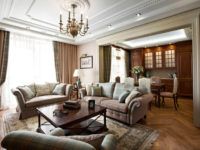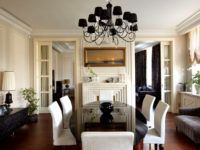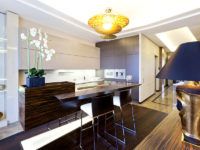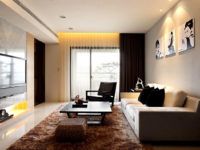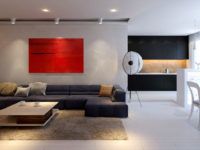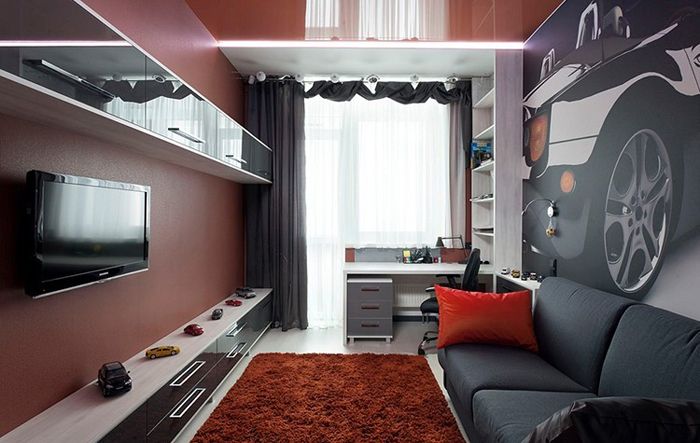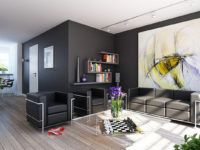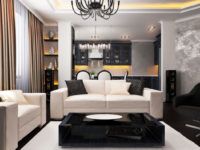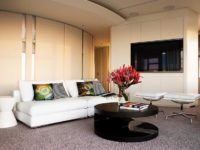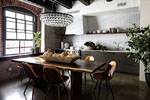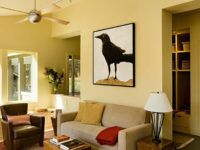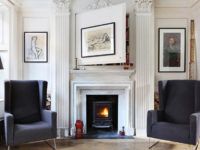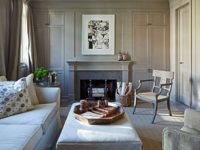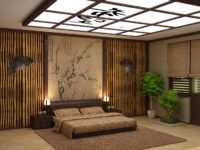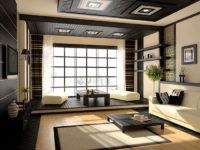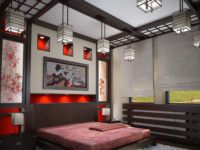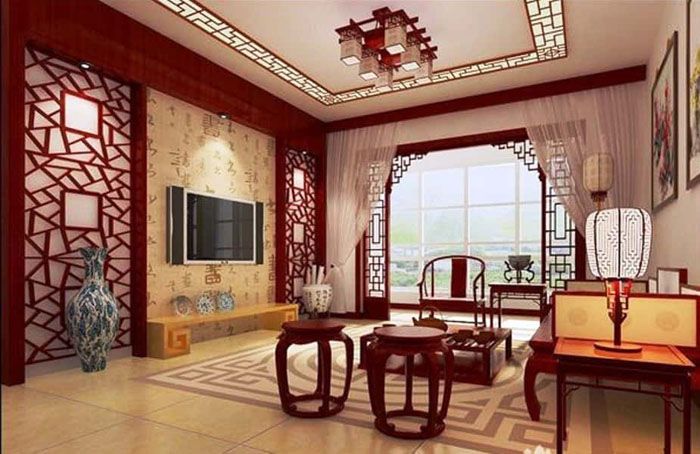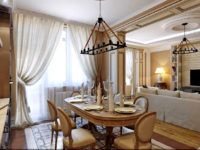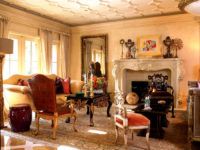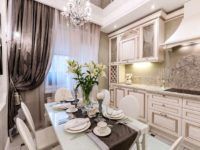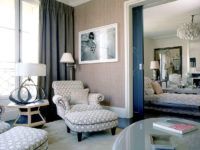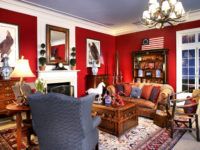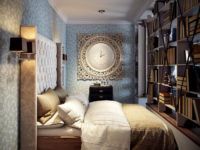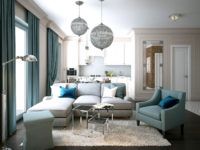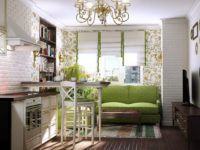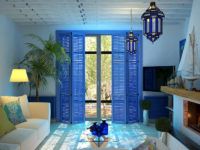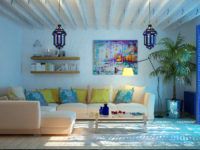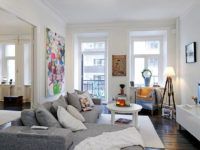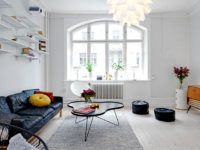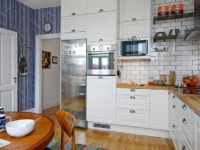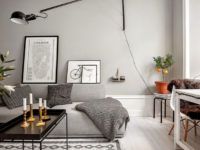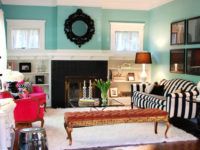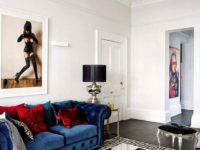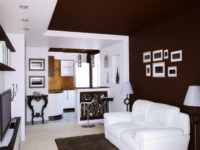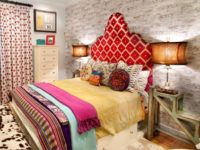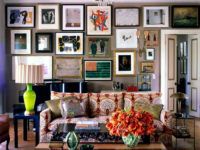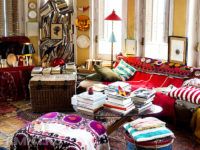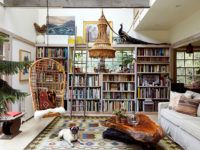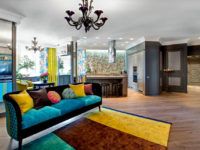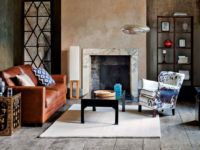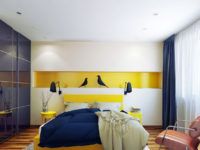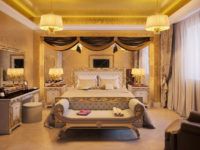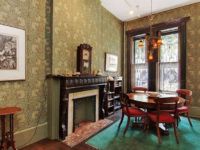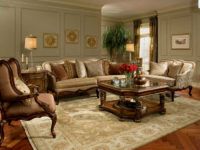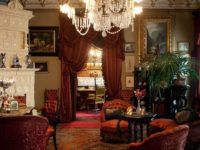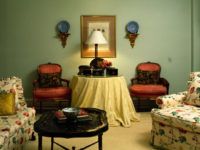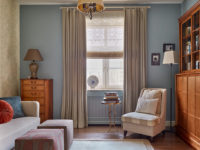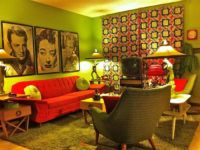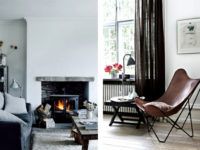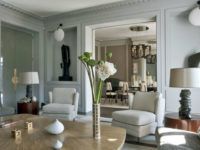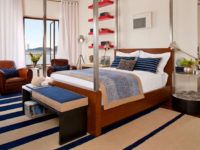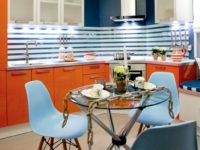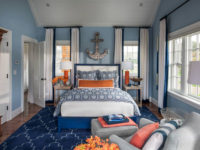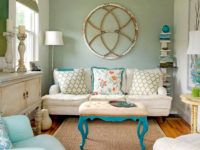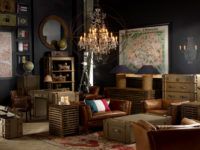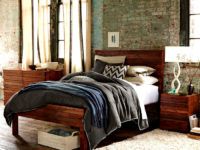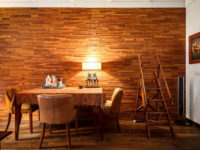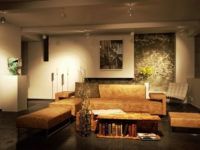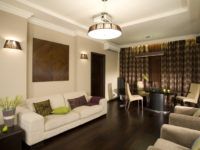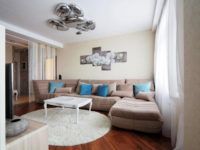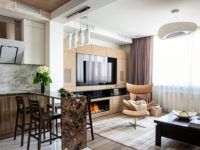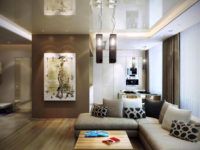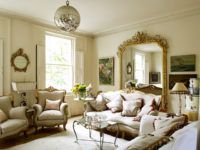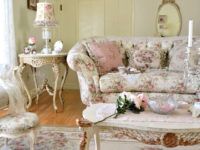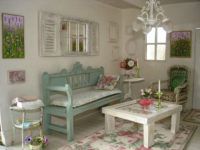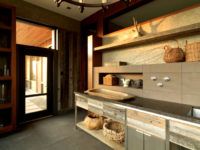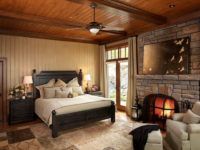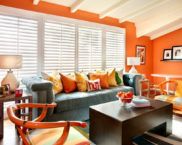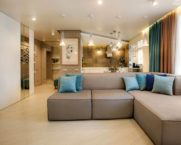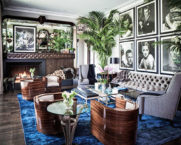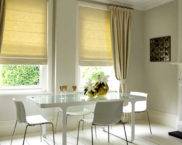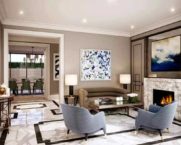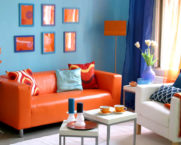A great overview of styles in the interior: photos with descriptions and videos
Life is complex and difficult, only revolutions and cataclysms can change its course. But everyone can change it by creating their own little world, cozy, beautiful and comfortable under the roof of their own home. We must pay tribute to humanity, because it has been doing this for a long time, since the era of cavemen who began to decorate the walls with drawings. Today we have the opportunity to choose from a fairly large list of proposed style directions. Therefore, in this article, we will consider all the styles in the interior. Photos with descriptions will help create a visual representation of each of them.
The content of the article [Hide]
- 1 The main categories of style trends in room design
- 1.1 Classic
- 1.1.1 Video: classic style apartment
- 1.1.2 Rococo
- 1.1.3 Baroque - royal style in the interior
- 1.1.4 Art Nouveau style in the interior of apartments and houses
- 1.1.5 Provence style in the interior
- 1.1.6 Renaissance
- 1.1.7 Features of the English style in the interior
- 1.1.8 Greek
- 1.1.9 Roman
- 1.1.10 Romanesque
- 1.1.11 Gothic
- 1.1.12 Classicism
- 1.2 Contemporary styles
- 1.2.1 Art Deco
- 1.2.2 Minimalism
- 1.2.3 High-tech style in an apartment interior
- 1.2.4 Special features of country style in the interior
- 1.2.5 Alpine style - chalet
- 1.2.6 Art Nouveau interior: distinctive features
- 1.2.7 Family Style - Pop Art
- 1.2.8 Photo and video examples of loft style in the interior
- 1.2.9 Naturalness of eco style in the interior
- 1.2.10 Space of neoclassicism in the interior
- 1.3 Ethnic styles
- 1.4 National styles
- 1.5 Mixed style
- 1.1 Classic
- 2 A quick look at other styles
The main categories of style trends in room design
Let's make a reservation that style directions are based on the experience of many peoples, therefore, the main part of the styles is called either the place where it arose, or the name of the people who created it for more than one century. But they are all united by four categories.
So, here are four categories:
Let's take a look at all the categories separately and denote which styles are included in each of them. We will find out how they differ from the rest, what are their features, we will show photographs indicating the subtleties of the definition.
Classic
We must pay tribute that the classics in design have undergone some changes. Therefore, you can often hear such a name - modern classical style. This does not mean that he has become very different from his own characteristics. Simply making repairs and choosing classics, modern people began to replace materials with new ones that have appeared on the market over the past decades. Here, artificial analogs are most often used, which replace natural, natural ones. This reduces the cost of the project, but in no way detracts from their quality.
The second position, which gives the right to call the classics modern, is the transfer of the design itself from large palaces and halls to small rooms in city apartments and country cottages. That is, in this regard, the classical style has gradually become unified. But its content remained the same, because the basic features and concept were preserved.
What is the difference between the classics in the interior of the rooms and other styles:
But, as noted above, the classics have one important aspect that will have to be maintained both in an apartment and in a huge private house. This is space. You can not fill up the premises for the sake of style requirements, especially if the room does not have enough space.It is better to reduce the amount of furniture, accessories, architectural forms, but play with color, lighting, curtains and other elements. And it will not be difficult to do this, because the classic style is one of the few that adapts to the various possibilities of the room.
It is clear that one of the main categories includes several directions. The classics include those that meet the requirements described above. Therefore, you can safely add here: Rococo, Baroque, Gothic, Classicism, Modern, Provence, Renaissance, Greek style, Ancient Roman, English and Romanesque. Let's take a look at all the directions separately.
Video: classic style apartment

Rococo
Rococo style in the interior appeared in the eighteenth century, and it is based on Greek myths and fairy tales. In terms of sophistication, this is one of the most unique destinations in which comfort and luxury are intertwined. Therefore, the room is filled with a lot of furniture. This is not only a soft group (sofa and armchairs), but also several ottomans, couches, tables, dressers and other items.
The color scheme is pastel shades interspersed with turquoise, azure and blue. Gold and silver are usually found in abundance. At the same time, a distinctive feature is the design of the walls, where ancient heroes, fairy-tale characters are present. The walls are not necessarily finished with paints. Rococo is most often a fabric drapery, where tapestry is preferred.
The Rococo ceiling is the fifth wall, which is decorated as well as the walls. Stucco moldings, patterns and drawings are welcome here. Very often the technology of the paduga is used, when the line between the ceiling and the wall is erased in the general design of the space.
As for the floor, there are no strict requirements in the Rococo style. It can be wood, stone, tiles and other materials. Carpets are also part of the interior. In many rooms, they cover a large area of the floor base.
As for furniture, here the best option is small, but comfortable and functional. In this case, sophistication must be taken into account. The furniture is completed with empire heads, carvings. Statuettes are placed on the shelves, and an old grandfather clock can stand on the floor. That is, everything should be rich. Therefore, crystal and porcelain will also be appropriate here.
Of course, all this cannot be crammed into a city apartment, so a modern, more simplified Rococo style was created. Curls remained on furniture, mirrors, for the most part gilding and silver left, fullness began to strive more for minimalism, that is, an urban atmosphere appeared. But sophistication, charm, wealth, even in modern content, remained.

Baroque - royal style in the interior
This is one of those few styles that declares itself with refinement, luxury and pomp in all known forms. This is a royal style that embodies the plasticity of forms from precious metals and precious woods. These are the main distinguishing features of the Baroque:
It's unforgettable that Baroque is one of the oldest styles, so it's worth taking care of paintings and statuettes. The first ones are hung on all walls, for the second ones you need to make niches. Yet this style requires large spaces. It is almost impossible to create it in city apartments, although practice confirms the opposite.
Art Nouveau style in the interior of apartments and houses
This trend appeared at the end of the 19th century, and was popular for a short time. Today it has revived again only because the main rule of style is the designer's imagination, practically unlimited. But Art Nouveau has its own features: smooth and curved shapes, complete asymmetry, the absence of clear boundaries and sharp corners. Let's add here floral motifs in the interior, natural colors and natural materials:
In general, the natural theme should be present everywhere: paintings, vases with flowers, unusual lamps, figurines, and more. And one piece of advice - do not zoning a room in the Art Nouveau style. Even if it is necessary, then it should be done with blurred boundaries.
Provence style in the interior
Transferring the rustic flavor to urban life is the dream of a fairly wide circle of residents of megacities. It was under this desire that the Provence style appeared. For obvious reasons, each nation has its own ideas about rural life, but the name of the style came from France.
And although many people believe that Provence is still the same country, but, as the content and features of the styles show, these are two different directions. Moreover, country in its modern interpretation refers to modern styles. So, the distinctive features of the French style of Provence in the house: a lot of plants, simplicity of decor and its naturalness, shabby elements and colors. The basis of the style is the archaic nature of the environment, which does not tolerate fuss.

Renaissance
This style direction is called the style of the Renaissance. The spirit of antiquity, the highest degree of home improvement is the basis of the Renaissance. Today the style is not so much in demand, but if there is a desire to create a spectacular interior design of a room, then this direction is the best. You will not find sharp contrasts in it. Here everything flows smoothly from tone to semitone. Everything is in harmony in one palette, this creates a calm atmosphere.
Since the Renaissance is based on antiquity, stone is the main material for decoration. It is present everywhere: on the floor and on the walls. Often ceilings, and they should be domed, are finished so that there is an imitation of stone. Frescoes, drapery, wood paneling - all this is present. Niches are necessarily built on the walls where luxury items or household items are installed. Parquet can be laid on the floor, but it must be made of a wide board.
It is believed that the Renaissance is the style of kings. But surprisingly, the amount of furniture in this direction is small. It should be of high quality - no doubt about it, but often it's just a padded band, a table with chairs and a couple of dressers. That is, the style of the Renaissance is a lot of air, space and light.
As for lighting, it is achieved through wide and tall windows. In the dark, these are large lamps, often forged, with a large number of light sources. Everything is stylized like candelabra. Several copies of Raphael, Da Vinci or Michelangelo only emphasize this style. We add that the Renaissance is a universal direction. It can be created in any room, the experience and qualifications of the designer are important here.
Features of the English style in the interior
Straight shapes, precision in everything, rare expensive items, general elegance of the room - this is the English style. It will fit any room size. It can be created both in apartments located in Khrushchev buildings and in a large private house. In addition, this is not difficult to do, because the furnishings of the room can be minimal: two large closets located opposite each other, a fireplace and a large armchair near it.
The main requirement is to create a noble interior. Therefore, only the best expensive materials, refined pieces of furniture and accessories are selected for decoration. It should be wood, not MDF or chipboard, especially no plastic. Only natural fabrics: cotton, linen, wool.
Convenience is also an integral part of the furnishings. For example, there should be a table near a sofa or an armchair, a bedside table near the bed. An abundance of shelves on which everything that has been acquired is placed, as it were, on display. Carpets and fireplace are a must. Let them be small, but they must be there, and it doesn't matter in which room.Very often in rooms decorated in the English style, large cabinets with books are installed. The library is welcome in this direction.
Greek
The Greek style in the interior has two features - sophistication and elegance in everything. If you want your home to emphasize its power, choose this very direction in the design of interior rooms. The idea of the style itself is perfection and harmony of forms and a complete absence of ostentation. But you should not classify it as "economy". Greek style is expensive.
Here are the basic rules for this style direction:

Roman
Distinctive features of the Roman style: sophistication, delicate taste, wealth and luxury. We must pay tribute to this direction, because its elements have entered other style schools. Namely: arches, columns, domed ceilings, round vaults and so on.
Romanesque
Knights, beautiful princesses, kings and their rich vassals - this is the Romanesque trend, which combines cold stone and warm wood. This is the majestic severity of the old grandmother of Europe. Therefore, the main design touches are the severity, gloom and asceticism of the internal content. No frills:

Gothic
The designers designated the Gothic style used in the interior as a kind of crown of the cultural heritage of Western Europe. It can be characterized as follows: striving for the highest with the help of luxury, grace, expressiveness and exorbitant grandeur. You just need to remember what the churches and temples of the late 19th century were like. And this is brickwork, colored glass, pointed turrets, paintings on the walls, a fireplace and so on.
In addition, the Gothic style is high ceilings and a lot of air, so it cannot be created in an apartment. And in the house there can be problems with it, because one room cannot contain everything that the Gothic style owns. Therefore, designers always propose projects that span two floors of the building. That is, the design of the castle will be recreated inside the house.
And about the rules for creating a Gothic style:
Classicism
The school of this direction was created by a large number of architects and designers who chose the most unique elements from antiquity. And most importantly, they were chosen on the principle of not being overloaded with unnecessary details. Therefore, classicism is a complete interconnection of all interior elements with each other, one hundred percent symmetry, calm and strict composition, not devoid of grace. Color scheme - in light colors:
In general, classicism can be characterized as follows - expensive, but restrained. The cost of an investment should not be overwhelming.
Contemporary styles
How can you characterize this style direction - this is the design of the present moment. That is, it is the speed of our time, the fast pace of life, the overload of information, the change of the world. The consequence of all this is the uselessness of comfortable living conditions. Therefore, modern styles in the interiors of apartments are a minimum of furniture, strict lines, a lot of light, chrome and glossy surfaces (in the photo below, all this will be clearly visible). Let's consider some of them as the brightest representatives.
Art Deco
Translated from French, Art Deco means decorative art. Its main content is grace and luxury. Used this school mainly for the decoration of hotels, restaurants, cruise ships. In modern design, designers began to use cheaper finishing materials, but the surroundings of luxury did not decrease. Furs, stainless steel trim, silver, crocodile leather accessories, ivory elements and figurines, rare wood and stone - all this is Art Deco. At the same time, the color filling is not limited by anything, the main thing is grace and luxury.
But in order to create the right atmosphere, the designers propose not to deviate from the basics of the style: distorted figures, geometric shapes of a multi-stage type, gaps, zigzags, interspersed with oriental or Egyptian ornaments, tropical plants intertwined with each other, exotic animals and others. In general, the art deco style in the interior (photos are presented below) is a fantasy, a mixture of several styles: from cubism and futurism to modern and neoclassicism. And although many do not like this direction, you can still call it comfortable, especially in the kitchen and bathroom.
Today, designers approach the application of this style with great care. More and more often, abstract paintings or photos on the theme of love and romanticism are used on the walls. As for the color solutions, there are no strict rules here either, everything is selected taking into account the preferences of the owner of the house. As for furniture, preference is given to leather elements, with metal, glass and crystal inlaid finishes.
Minimalism
You can designate this style with the following features:
The minimalism style in the interior requires a lot of space, so no partitions, even the walls are often removed. The zoning of the space is done by lighting, color, curtains, furniture arrangement.
High-tech style in an apartment interior
Hi-tech appeared at the turn of times, when the technical breakthrough of humanity began. Space flights, the production of various smart technology, television and other benefits of civilization became the basis of this style school. Therefore, the design contains only modern building materials, where metal, plastic and glass dominate. The photo below shows the interior of a living room with an area of 18 meters, decorated in a modern high-tech style.
Special features of country style in the interior
The village style is determined by the way of life of the people in a particular region. Therefore, each country has its own country style. But there are similar components that distinguish him from other style schools. First of all, this is the design of a village house, and secondly, simplicity and naturalness:
Today, more and more often, apartment owners themselves create a country style, so to speak, with their own hands. If someone from the family knows how to do something, for example, burn wood, cut carvings, knit, assemble unpretentious furniture, then such a design can be quickly filled with the necessary accessories. For example, the photo below shows a country-style bedroom, where everything is decorated almost with your own hands: pictures above the bed, an unpretentious bedside table made of scrap materials, a deer head made of plaster.
Alpine style - chalet
The chalet - aka a shepherd's hut, aka an alpine house - is distinguished by its own architecture:
The main content of the chalet style in the interior is good quality and comfort, therefore it is often chosen by romantic couples. By the way, many designers do not distinguish it from the country category, believing that such a house is designed in a rural style from the inside. There is some truth in this, but I must add that this style direction sharply stood out in a separate group after the popularity of alpine skiing.
But the chalet has its own character, which is determined by the presence of only wood and stone, unpretentious decor, massive simple and comfortable furniture, large-sized items of a soft group, a hearth (fireplace). Other distinctive features:
We must immediately make a reservation that it is difficult to create a chalet in a city apartment, there is too little space. And artificial materials cannot reflect all the advantages of stone and wood. Therefore, we suggest looking at a few photos of the interior of a chalet-style country house.
Art Nouveau interior: distinctive features
This is a pure modern style, therefore only modern materials are used in it, namely plastic, glass and metal of various origins. This applies not only to decoration, but also to furniture with accessories. The main idea of the style is convenience in versatility. At the same time, strict geometry is taken into account, where there is a place for fantasy:
It should be noted that there is a subspecies of modernism called postmodernism. They differ from each other little. But if modernism is a constant search and change, then postmodernism is a style that has already found everything that is needed. The only thing to add is that postmodernism has a kind of extravagance. It should contain items and accessories that you will not find in another house, apartment or room. It should be exclusive, full of non-standard solutions.
Family Style - Pop Art
This style differs greatly from others. It has rainbow colors, expression, non-standard shapes, constant repetition of details, emotions and energy. All this mixture creates an unusual high mood. Therefore, designers often call this style a family style.
Its special features include the full fantasy of the master, therefore:

Photo and video examples of loft style in the interior
This style trend emerged in the middle of the last century in the United States. Then from New York they began to take out factories and plants outside the city, and sell old industrial facilities for a song. Enterprising people bought them up, converted them into housing and rented them out. At first, poor people lived in such houses, because the decoration practically did not change from the factory. But later, rich people began to buy such apartments, because they were able to see something non-standard, unusual in this setting.
Distinctive features of the loft style are high ceilings, a lot of free space, large windows, almost the entire wall, beams, supports, pipes under the ceiling. That is, there was freedom of planning with the ability to neutralize the above-described "disadvantages". The word "Loft" itself is translated as attic, attic. And since the old factories are one-story buildings with a high roof, the similarity to the attic is obvious.And even later, when the roofs were dismantled and the buildings were built on several floors, the name remained.
An interesting fact is that the style was becoming very fashionable. Already no one bought up warehouses and industrial facilities and did not arrange housing in them. But architects began to propose projects for multi-storey buildings in the loft style. That is, with large windows, freedom of planning and finishing for warehouses and factories. The photo below shows a loft-style room in one of these houses.
The obligatory attributes of this style direction are industrial accessories such as pipes, wires and cables, without which the premises turn into ordinary rooms. But the designers gradually began to move away from these attributes, mainly in new buildings. The style has been updated. All the rest, and this is a rough finish, high ceilings, high windows, freedom of planning, remained.

Related article:
Naturalness of eco style in the interior
The name itself already suggests that only natural materials should be used in the interior of rooms decorated in eco style. There is no place for synthetics and plastics. Therefore, stone, glass, wood, cotton, linen and other materials form the basis of the style. This also applies to decoration, furniture, and accessories:
Eco style appeared recently and it has not yet gained its clear positions. But certain norms are already taking shape. It is believed that this is a rather strict style, which designers are trying to dilute with decorative items, for example, wooden or clay vases, jugs, wicker chests or bunches of dry plants. But it cannot be called unique, because the eco-style has absorbed a little bit from various other style directions.
Space of neoclassicism in the interior
The decoration of luxurious palaces excites the minds and contemporaries. Many people want to live beautifully and richly. But small rooms of apartments do not allow this. Wrong scope, wrong scale. Therefore, a new style for interiors has appeared - neoclassicism, which is translated in this way - a new classic.
But there is no clear concept of what this direction is. Therefore, neoclassicism is considered a flexible style. That is, it combines many traditions in itself, but at the same time it easily adapts to modern conditions. That is why it is classified as a modern style. This direction has one special feature - the style loves space, therefore it cannot be created in small apartments in Khrushchev. In new buildings with large rooms, you can try to create a more concise version, but not the fact that it will turn out:
Related article:
Ethnic styles
Many people mistakenly believe that if you install paper-filled partitions in the room, then you can already talk about the Japanese style. Or hang a few masks, a spear and a bow with arrows, then you can already assume that you have an African style in your house. Ethnic styles are environments specific to specific peoples and nations. It takes into account not only attributes, but also color schemes, the correct arrangement of furniture, and so on.
African
This is the most mysterious and daring style. Africa itself is an ambiguous region, there are endless shrouds, deserts and jungles. That is, the color palette is so diverse that you have to choose exactly what the owner of the premises wants to see. For many, it may seem that black should be present in large quantities, but this cannot be done. It should be, but in the form of inclusions.
Today, designers have divided the African style into two large groups: Moroccan and Egyptian, because it is in these regions that there is some designation of the national color. But often, denoting the style of Africa, designers simply play with it with a color scheme and the presence of certain accessories in the form of masks and knives.
Egyptian
Its basis is the gold and wealth of the pharaohs, therefore, against the background of white, beige and sandy walls and ceilings, golden elements must be present. At the same time, it is very important to bring into the design a blue color that personifies the water of the Nile:
Moroccan
The Moroccan style is the original culture of the people, in which East and West are intertwined. Therefore, the interior has a huge number of colors. At the same time, mixing took place at almost all levels. For example, the arch came to Africa from the west, and its upper part in the form of a pointed dome is an element of oriental style in the interior.
Therefore, when the conversation comes to the design of the walls, ceiling and floor, then there are no special restrictions. The main stance of the Moroccan style is the little things. For example, the complete absence of large furniture. Mostly they use poufs, foot stands, small pedestals and more. Podiums are used as sofas. The most important thing is that restraint, a combination of textures and colors, a sense of proportion - this in no way refers to the Moroccan style direction.
Japanese
Asceticism is the basis of the Japanese style in the interior. Therefore, a minimum of furniture and accessories. There are no walls or partitions, only screens. A huge empty space filled with a minimum of objects that can be increased or decreased using movable partitions.
The interior is based on light-colored wood.This applies not only to decoration and furniture, but even to curtains depicting bamboo. In general, talking about the Japanese style is both simple and difficult. Therefore, it is better to look at the photo and understand how to properly organize the space, and how to decorate it.
Chinese
It can be characterized as follows - energetic, simple and natural. There is no clutter in it, but the objects installed in the room must be located correctly. Screens, partitions play a double role - directly protective structures and decorative elements.
As for the color scheme, natural shades of wood are welcome. But red, as the personification of life and good luck, is one of the favorites in Chinese ornament. Mandatory attributes are large floor vases, amphora-shaped lamps, paintings depicting birds and bamboo.
National styles
The list of ethnic styles used in interior design can be continued for a long time, because there are many interior styles in this direction. For example, Mexican, tropical. But one must understand that there is a fairly large layer of schools that cannot be attributed to any category. For example, the Russian style used in the interiors of rooms and apartments, and houses.
So that you understand at least approximately what schools you can talk about in a purely national style, we will offer several photos showing different styles. They are not ethnic, they are national styles that did not fall into the category of classics and modern schools. Italian style is a mixture of antiquity, tradition with modern unified living conditions. Look at the photos of the interiors.
Features of the French style in the interior
There are three main criteria here - delicate taste, luxurious simplicity and incredible comfort of the environment. Provence is also considered a French style, but it is suitable for country houses. In this article, we are interested in apartments.
American style democracy in the interior
The first colonists used the interiors inherent in their homes in the decoration of their homes. But the difficult conditions of the new place, the hardships they experienced, left an imprint not only on life and everyday life, but also on the interior design. Although the basic framework is English classics. The style itself has become simpler. And if earlier designers attributed it to the colonial style in the interior, today they singled it out in a separate direction. The emergence of art deco made changes, so the American style (modern) became campy, most of all it absorbed Hollywood luxury. But even in this case, there are more democratic notes in it.
Options for Mediterranean styles in the interior
This style can be attributed to the national one with an interference, because in it the peoples living around the Mediterranean Sea are intertwined: Turks, Greeks, Italians, Moroccans, Egyptians and others. Therefore, the style turned out to be diverse.
Options for the implementation of the Scandinavian style in the interior of the apartment
The whiteness of the snow, the blue of the sea, calm colors, like the character of the inhabitants of Scandinavia. These are the distinctive features of this school. The most amazing thing is that any item, accessory fits well into the style, the main thing is its color content. We will show a photo of the use of the Scandinavian style in the interior of small apartments.
Mixed style
In this category, one direction is eclecticism. The school emerged from the places where the transport routes of the peoples who traded with each other crossed. Therefore, eclecticism in the interior is a mixture of not only national cultures, but time intervals.
A quick look at other styles
There are a lot of styles. We have considered the most famous, but there are others that differ from those described in their special character.
Anarchic boho style in the interior
The main trend is a large number of necessary and unnecessary things, cluttering up the space, a large number of pieces of furniture, accessories, paintings, all kinds of pillows and other things. There are no rules here, there are no laws here, complete anarchy inherent in hippies.
Fusion interiors in the interior
Remember minimalism, this is its complete opposite. Experiment, imagination is welcome here, no rigid framework. But everything is done with taste, the interior is stylish.
Empire style
This style direction appeared during the reign of Napoleon. It emphasizes the status, therefore it is often called also palace or imperial. It is difficult to create an Empire style in the interior of apartments; a large house is needed here. And in one room it will not always look appropriate, it requires a scale. Although the designers manage to do this.
Victorian style
The Victorian style cannot be called definite, because they try to arrange each room for a different interior. But the basis is expensive materials, furniture and accessories. At the same time, everything should be reliable, it is not for nothing that this style was invented by the bourgeois, who got rich during the reign of the British Queen Victoria.
Retro style
In fact, it is a stylization of the room, which uses old schools. But there is also a feature - moderation in everything. Therefore, a pair of massive armchairs, velvet upholstery, wooden mirror frames, candlesticks, wallpaper on the walls with geometric patterns - all this is the retro style in the interior of the apartment rooms.
Hugge
This direction came from Denmark, where dimensional life created all the conditions for people to enjoy the warmth and comfort of their own home. Therefore, the main features of the hygge style in the interior were light colors, natural decor, blankets and pillows, wood, simple textiles.
Nautical
The name itself speaks for itself. The nautical style is white, blue and light blue that prevail in interior design. The marine theme is important here, although designers often deviate from tradition, introducing completely different additions to the marine theme. And this does not spoil the interior.
Interiors of rooms in vintage style
Vintage is a French word for strong old wine. It has been transferred to interior design, which denotes the presence of old things in a modern setting. The most important thing is that things should not just be old, but popular in their time. This is what makes this style different from the retro direction. That is, the latter does not depend on fashion.
To recreate a vintage style, you have to choose an era. That is, you need to collect things from only one time period. And since we live in the 21st century, things from the middle of the 20th century can already be considered vintage.
Grunge
This style began in country hunting lodges, where a lot of furniture was not required, but a peculiar taste was preferred. Therefore, this direction requires a lot of free space, a lot of light and air. Hence the conclusion - grunge style is rarely found in apartment interiors. This is especially true for Khrushchev.
Contemporary
This is a modern approach to solving the problems of decorating apartments and offices. But it does not fit into either high-tech or minimalism. The main focus is common sense and convenience. Contemporary style in apartment interiors is a combination of items that are bought in a store. The rest is not used here. No restrictions on color, light or layout.
Shabby chic
Translated from English, shabby means old. That is, the style is old chic. When you look at the objects that fill the interior, decorated in the style of shabby chic, it becomes clear that they are more than a dozen years old. But at the same time, the room itself does not look shabby or not repaired. And while the shabby items make the interior simple, you can be served tea in Ming cups or seated on a Victorian sofa.
Rustic
Rustic style is a brutal, rough, but natural filling of the room.Here, natural natural materials, imperfect shapes and lines are combined with elegant accessories and decor.
So, we considered a large number of different styles that can be used to decorate rooms in apartments and private houses. Confusion may appear in your head from all this information, which will not allow you to immediately determine the direction that you like. Therefore, it is worth taking a closer look at the photos and understanding which one is more to your liking. If you have any questions, or we did not touch on some styles in this article, and you would like to get more information about them, then write in the comments. The editors of our site will try to fill in the missing information.











